|
April
Important
historic dates in science
April
30:
Electron
In 1897, at the Royal
Institution Friday Evening Discourse, Joseph John Thomson (1856-1940)
first announced the existence of electrons (as they are now named). Thomson
told his audience that earlier in the year, he had made a surprising discovery.
He had found a particle of matter a thousand times smaller than the atom.
He called it a corpuscle, meaning "small body." Although Thomson
was director of the Cavendish Laboratory at the University of Cambridge,
and one of the most respected scientists in Great Britain, the scientists
present found the news hard to believe. They thought the atom was the
smallest and indivisible part of matter that could exist. Nevertheless,
the electron was the first elementary particle to be discovered.
April
29:
X-ray research in humans
In 1998, it was revealed
in Oslo that in experiments conducted for decades until 1994, Norwegian
and American researchers used mentally ill or retarded Norwegians in tests
of the biological and genetic effects of X-ray radiation on the body.
April
28:
Wave mechanics
In 1926, the term
"wave mechanics" was coined by nuclear physicist Erwin Schrödinger
in a letter he sent to Einstein. The term was applied to the newly emerging
branch of physics which interprets the behavior of subatomic particles
according to a mathematical description in terms of a wave motion.
April
27:
Maurice de Broglie
(Born April 27, 1875:
Died July 14, 1960)
Maurice de Broglie was a French physicist who made many contributions
to the study of X rays. While in the navy (1895-1908), he first distinguished
himself by installing the first French shipboard wireless. From 1912,
his chief interest was X-ray spectroscopy. His "method of the rotating
crystal" was an application of Bragg's "focussing effect"
to eliminate spurious spectral lines. De Broglie discovered the third
L absorption edge (1916), which led to the exploration of "corpuscular
spectra." During 1921-22, he worked with his brother Louis to refine
Bohr's specification of the substructure of the various atomic shells.
He also did pioneer work in nuclear physics and cosmic radiation.
April
26:
Chernobyl nuclear plant explosion
In 1986, in Pripet,
Russia, the Chernobyl nuclear plant exploded in the world's worst civil
nuclear catastrophe which sent a cloud of radioactive dust over Europe.
It was the result of an experiment went wrong, causing the fourth reactor
to explode and melt down. Thirty-one people, mostly firemen, were killed
immediately after the explosion, and several thousand more - those involved
in the clean-up and children - have since died from radiation-related
illnesses. Ukraine says the health of millions of its people have been
affected by the disaster.
April
25:
Atomoic Reactor
In 1957, an experimental sodium reactor (SRE) began operation producing
about 6,000 kilowatts of electricity. It was located about 30 miles northwest
of Los Angeles, in the Santa Susana Mountains, California. It was built
for the Atomic Energy Commission by Atomics International, a division
of North American Aviation., Inc.
April
24:
Hendrik Anthony Kramers
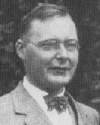 (Born
December 17, 1894: Died April 24, 1952) (Born
December 17, 1894: Died April 24, 1952)
Dutch physicist who, with Ralph de Laer Kronig, derived important equations
relating the absorption to the dispersion of light. He also predicted
(1924) the existence of the Raman effect, an inelastic scattering of light.
Kramer's work covers almost the entire field of theoretical physics. He
published papers dealing with mathematical formalism of quantum mechanics,
and others on paramagnetism, magneto-optical rotation, ferro-magnetism,
kinetic theory of gases, relativistic formalisms in particle theory, and
on theory of radiation. His work shows outstanding mathematical skill
and careful analysis of physical principles.
April
23:
Max von Laue
(Born October 9, 1879: Died April 23, 1960)
German recipient of the Nobel Prize for Physics in 1914 for his discovery
of the diffraction of X rays in crystals. This enabled scientists to study
the structure of crystals and hence marked the origin of solid-state physics,
an important field in the development of modern electronics.
April
22:
Fritz Strassman
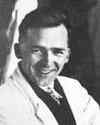 (Born
February 22, 1902: Died April 22, 1980) (Born
February 22, 1902: Died April 22, 1980)
German physical chemist who, with Otto Hahn and Lise Mietner, discovered
neutron-induced nuclear fission in uranium (1938) and thereby opened the
field of atomic energy used both in the atomic bomb for war and in nuclear
reactors to produce electricity. Strassmann's analytical chemistry techniques
showed up the lighter elements produced from neutron bombardment, which
were the result of the splitting of the uranium atom into two lighter
atoms. Earlier in his career, Strassmann codeveloped the rubidium-strontium
technique of radio-dating geological samples.
April
21:
Sir Edward Appleton
(Born September 6, 1892: Died April 21, 1965)
Sir Edward (Victor) Appleton, was an English physicist, born in Bradford,
who won the Nobel Prize for Physics in 1947 for his discovery of the so-called
Appleton layer of the ionosphere, which is a dependable reflector of radio
waves and as such is useful in communication. Other ionospheric layers
reflect radio waves sporadically, depending upon temperature and time
of day.
April
20:
Radium
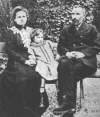 In
1902, Marie and Pierre Curie isolated one gram of radium, the first sample
of the radioactive element. They had refined it from eight tons of pitchblend
ore.
In
1902, Marie and Pierre Curie isolated one gram of radium, the first sample
of the radioactive element. They had refined it from eight tons of pitchblend
ore.
April
19:
Albert Wallace Hull
(Born April 19, 1880: Died January 22, 1966)
 American
physicist who independently discovered the powder method of X-ray analysis
of crystals (1917), which permits the study of crystalline materials in
a finely divided microcrystalline, or powder, state. His first work was
on electron tubes, X-ray crystallography, and (during WW II) piezoelectricity.
In the 1920's, he studied noise measurements in diodes and triodes. In
the 1930's, he also took interest in metallurgy and glass science. His
best-known work was done after the war, especially his classic paper on
the effect of a uniform magnetic field on the motion of electrons between
coaxial cylinders. He also invented the magnetron (1921) and the thyratron
(1927), and other electron tubes with wide application as components in
electronic circuits. American
physicist who independently discovered the powder method of X-ray analysis
of crystals (1917), which permits the study of crystalline materials in
a finely divided microcrystalline, or powder, state. His first work was
on electron tubes, X-ray crystallography, and (during WW II) piezoelectricity.
In the 1920's, he studied noise measurements in diodes and triodes. In
the 1930's, he also took interest in metallurgy and glass science. His
best-known work was done after the war, especially his classic paper on
the effect of a uniform magnetic field on the motion of electrons between
coaxial cylinders. He also invented the magnetron (1921) and the thyratron
(1927), and other electron tubes with wide application as components in
electronic circuits.
April
18:
Maurice Goldhaber
Born April 18, 1911
U.S. physicist whose contributions to nuclear physics include the discovery
that the nucleus of the deuterium atom consists of a proton and a neutron.
April
17:
Harriet Brooks
(Born January 1, 1876: Died April 17, 1933)
 Canadian
nuclear physicist who was probably the first to observe the recoil of
the atomic nucleus during radioactive decay as nuclear particles are emitted.
She was well known in the years 1901-5 for her original contributions
to the then youthful science of radioactivity. With Rutherford, she determined
the rate of diffusion of the radium emanation (radon) into air and other
gases, significant for they showed that the radium emanation diffused
like a gas of heavy molecular weight - estimated to be at least 100. Rutherford
credited her identification of radon as a vital piece of work that led
him to propose the theory of the transmutation of one element into another.
She died at the age of 56, from leukemia or a similar radiation-induced
disease. Canadian
nuclear physicist who was probably the first to observe the recoil of
the atomic nucleus during radioactive decay as nuclear particles are emitted.
She was well known in the years 1901-5 for her original contributions
to the then youthful science of radioactivity. With Rutherford, she determined
the rate of diffusion of the radium emanation (radon) into air and other
gases, significant for they showed that the radium emanation diffused
like a gas of heavy molecular weight - estimated to be at least 100. Rutherford
credited her identification of radon as a vital piece of work that led
him to propose the theory of the transmutation of one element into another.
She died at the age of 56, from leukemia or a similar radiation-induced
disease.
April
16:
John Hadley
(Born April 16, 1682: Died February 14, 1744)
British mathematician and inventor who improved the reflecting telescope,
producing the first such instrument of sufficient accuracy and power to
be useful in astronomy.
April
15:
Jean-Charles-Galinard de Marignac
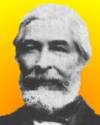 (Born
April 24, 1817: Died April 15, 1894) (Born
April 24, 1817: Died April 15, 1894)
Swiss chemist whose life work consisted of making many precise determinations
of atomic weights suggested the possibility of isotopes and the packing
fraction of nuclei. He began a study of the rare-earth elements in 1840,
when barely 23 years old. In 1878, he heated until it decomposed some
erbium nitrate obtained from gadolinite. Extracting the product with water
he obtained two oxides: a red one he named erbia and a colourless one
he named ytterbia. Thus he discovered ytterbium, and later was a codiscover
of gadolinium (1880). By separating tantalic and columbic acids, he also
proved that tantalum and colubium (niobium) were not identical.
April
14:
Christiaan Huygens
 (Born
April 14, 1629: Died July 8, 1695) (Born
April 14, 1629: Died July 8, 1695)
Dutch mathematician, astronomer, and physicist, who founded the wave theory
of light, and made original contributions to the science of dynamics-the
study of the action of forces on bodies. Using a lens he ground for himself,
Huygens detected in 1655, the first moon of Saturn. In 1656 he patented
the first pendulum clock, which he developed to meet the need for an exact
measure of time while observing the heavens. Huygens studied the relation
of the length of a pendulum to its period of oscillation (1673). This
lead him to formulate theories on the centrifugal force in circular motion
which would influence Sir Issac Newton in formulating his Law of Gravity.
April
13:
Stanislaw M. Ulam
(Born April 13, 1909:
Died May 13, 1984)
Polish-American mathematician who played a major role in the development
of the hydrogen bomb at Los Alamos. He solved the problem of how to initiate
fusion in the hydrogen bomb by suggesting that compression was essential
to explosion and that shock waves from a fission bomb could produce the
compression needed. He further suggested that careful design could focus
mechanical shock waves in such a way that they would promote rapid burning
of the fusion fuel. Ulam, with J.C. Everett, also proposed the "Orion"
plan for nuclear propulsion of space vehicles.
April
12:
Igor Yevgenyevich Tamm
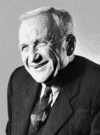 (Born
July 8, 1895: Died April 12, 1971) (Born
July 8, 1895: Died April 12, 1971)
Soviet physicist who shared the 1958 Nobel Prize for Physics with Pavel
A. Cherenkov and Ilya M. Frank for his efforts in explaining Cherenkov
radiation. Tamm was an outstanding theoretical physicist, after early
researches in crystallo-optics, he evolved a method for interpreting the
interaction of nuclear particles. Together with I. M. Frank, he developed
the theoretical interpretation of the radiation of electrons moving through
matter faster than the speed of light (the Cerenkov effect), and the theory
of showers in cosmic rays. He has also contributed towards methods for
the control of thermonuclear reactions.
April
11:
Macedonio Melloni
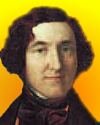 (Born
April 11, 1798: Died August 11, 1854) (Born
April 11, 1798: Died August 11, 1854)
Italian physicist who was the first to extensively research of infrared
radiation. After Herschel's earlier discovery of infrared radiation a
generation before, suitable tools were lacking until the invention of
a thermopile in 1830. That instrument was a series of strips of two different
metals that produced electric current when one end was heated. Melloni
improved the thermopile and used it to detect infrared radiation. In 1846,
from an observation point high on Mount Vesuvius, he measured the slight
heating effect of moonlight. He showed also that rock salt, being transparent
to infrared, made suitable lenses and prisms to demonstrate the reflection,
refractioin, polarization and interference of infrared in the same manner
as visible light.
April
10:
Giovanni Battista Amici
(Born March 25, 1786: Died April 10, 1863)
Astronomer and optician who made important improvements in the mirrors
of reflecting telescopes and also developed prisms for use in refracting
spectroscopes (instruments used to separate light into its spectral components).
April
9:
William Prout
(Born January 15,
1785: Died April 9, 1850)
English chemist best known for formulating Prout's hypothesis (1815) which
states that the atomic weights of all elements are exact multiples of
the atomic weight of hydrogen. At that time the atomic weight of hydrogen
was taken to be 1.0, the hypothesis implied that all atomic weights would
be whole numbers. In 1920, Rutherford named the proton after Prout.
April
8:
Harold Delos Babcock
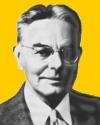 (Born
January 24, 1882: Died April 8, 1968) (Born
January 24, 1882: Died April 8, 1968)
American astronomer who with his son, Horace, invented the solar magnetograph
(1951), for detailed observation of the Sun's magnetic field. With their
magnetograph the Babcocks measured the distribution of magnetic fields
over the solar surface to unprecedented precision and discovered magnetically
variable stars. In 1959 Harold Babcock announced that the Sun reverses
its magnetic polarity periodically. Babcock's precise laboratory studies
of atomic spectra allowed others to identify the first "forbidden"
lines in the laboratory and to discover the rare isotopes of oxygen. With
C.E. St. John he greatly improved the precision of the wavelengths of
some 22,000 lines in the solar spectrum, referring them to newly-determined
standards.
April
7:
Atomic Electricity
In
1959, the first atomic generated electricity is produced at Los Alamos
Scientific Laboratory, New Mexico. The experimental model used a "plasma
thermocouple" in the reactor instead of a fullscale turbine, and
produced merely enough electrical power for a light bulb.
April
6:
Russian nuclear accident
In 1993, in Russia,
a huge radioactive cloud was released from an explosion of a tank of radioactive
waste at the secret military facility at Tomsk 7. Located in the Russian
wilderness, 1700 miles east of Moscow, it was the worse nuclear accident,
thought not the only one, since the incident at Chernobyl in Apr 1986.
A week later, delegates at a meeting in Tokyo from the world's richest
nations, agreed to give urgent help to Russia for problems with nuclear
waste, obsolete nuclear missile warheads, and aging nuclear reactors.
April
5:
Robert Oppenheimer
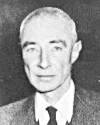 In
1963, the U.S. Atomic Energy Commission gave the Fermi Award to J. Robert
Oppenheimer for research in nuclear energy. Oppenheimer was the chief
scientist of the Manhattan Project during WWII that created the atomic
bomb. Later, he opposed the more destructive hydrogen bomb development
and his security clearance was revoked (1954). Nine years later, a wiser
U.S. government awarded Oppenheimer the prestigious Fermi Award, "For
contributions to theoretical physics as a teacher and originator of ideas,
and for leadership of the Los Alamos Laboratory and the atomic energy
program during critical years." The actual presentation of the medal
and $50,000 was made 2 Dec 1963 by President Lyndon B. Johnson. In
1963, the U.S. Atomic Energy Commission gave the Fermi Award to J. Robert
Oppenheimer for research in nuclear energy. Oppenheimer was the chief
scientist of the Manhattan Project during WWII that created the atomic
bomb. Later, he opposed the more destructive hydrogen bomb development
and his security clearance was revoked (1954). Nine years later, a wiser
U.S. government awarded Oppenheimer the prestigious Fermi Award, "For
contributions to theoretical physics as a teacher and originator of ideas,
and for leadership of the Los Alamos Laboratory and the atomic energy
program during critical years." The actual presentation of the medal
and $50,000 was made 2 Dec 1963 by President Lyndon B. Johnson.
April
4:
Sir William Crookes
(Born June 17, 1832:
Died April 4, 1919)
British chemist and physicist noted for his discovery of the element thallium
and for his cathode-ray studies, fundamental in the development of atomic
physics.
April
3:
Space nuclear power
In 1965, SNAP 10A,
the first nuclear reactor in space, was launched from Vanden berg Air
Force Base, Calif. It was activated by a signal from scientists on earth
about four hours later, and generated 500 kilowatt-hours of power during
its life, providing electrical power for a 1 kgf ion engine. While its
ground version lasted 10,000 hours without problems, the orbiting reactor
was shut down by an electrical failure in another of the satellite's systems
after 45 days in operation. It is still orbiting the earth. SNAP stands
for Systems for Nuclear Auxiliary Power. Although the Soviet Union has
flown many nuclear reactors in space, the SNAP-10A is the only one flown
by the United States.
April
2:
Theodore William Richards
(Born January 31, 1868: Died April 2, 1928)
American chemist whose research on the atomic weights of approximately
60 elements indicated the existence of isotopes and earned him the 1914
Nobel Prize for Chemistry.
April
1:
Dame Kathleen Lonsdale
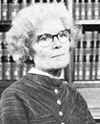 (Born
January 28, 1903: Died April 1, 1971) (Born
January 28, 1903: Died April 1, 1971)
British crystallographer who developed several X-ray techniques for the
study of crystal structure. Her experimental determination of the structure
of the benzene ring by x-ray diffraction, which showed that all the ring
C-C bonds were of the same length and all the internal C-C-C bond angles
were 120 degrees, had an enormous impact on organic chemistry. She was
the first woman to be elected (1945) to the Royal Society of London.
Click
here for previous months
March
February
January
Photos
courtsey of Today in Science
|

